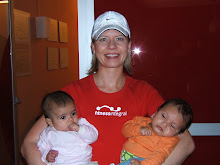
Today's blog comes to you thanks to my lovely postpartum ladies. If it wasn't for them, I wouldn't be the proud owner of some "CVBs".
First, let me give you a fair warning. My blog is about perinatal fitness and wellness. This includes sexual health and the pelvic floor. Pelvic floor includes the anus and the vagina (among other items). So, if any of these topics are not your cup of tea, stop reading now. Please don't continue reading and then write me a comment/email that you were grossed out or insulted in some way. Ok?
So the story goes like this.
Ladies in my postpartum groups were talking about how sex wasn't all that appealing now, how it was a bit painful, how they didn't have much libido, and how all this was effecting their lives and their relationships. Thankfully at my studio we talk about these issues openly with no embarrassment and the women are comfortable sharing intimate details about their health and well being. So, at the end of the conversation we had decided to have a "tuppersex party". This is like a Tupperware party but the items on sale are sex toys, lubes, massage oils, etc. This way the ladies wouldn't have to fight their way to a sex shop with baby, the stroller, the diaper bag in tow just to get some items that can bring sexy back to their romantic lives. It's all about making it easy for the new moms.
Here in Catalunya/Spain one of the common recommendations from gynecologists and physical therapists for strengthening the pelvic floor are these Chinese vaginal balls (CVB). In Catalan they are just called "Bolas chinas" or "Chinese balls". Basically they are 2 silicone balls a bit smaller than a golf ball attached by a silicone string. The balls have little weights inside and at the end of the string there is a silicone loop. The task is to insert these balls in the vagina and keep them there. That's it. When the pelvic floor is weakened (like after pregnancy and birth), it is difficult to keep the balls in the vagina and they may even fall out.
Second warning: Now comes the personal bit. If you are uncomfortable reading about me and my experience with these balls, stop reading now.
So, I bought some of these balls from the tuppersex lady. I always try everything that I suggest to my clients whether diets, workout plans, masseuse, osteopaths, acupuncturists, etc. I am my own guinea pig always first. So, if I am to suggest these Chinese balls to my clients as an aid to rehab the pelvic floor, I better try them myself.
They sent me pink balls! I ordered purple balls! :( (they didn't have blue ones. I really wanted some blue balls. hehehe)
One of the reasons I wanted to buy these balls now was to see more objectively the changes in my pelvic floor through pregnancy, birth, and recovery. We all know you don't know how far you've come (nice pun there...) if you don't know where you started. So, now I have a good baseline reading. For me, these balls stayed put through walking around my apartment, running in place, and doing some deep body weight squats. I get an A for pelvic floor strength!
These particular CVBs were like balls within balls. There was a weighted little ball inside the bigger ball. So what happens as you move is the inner ball bounces off the outer ball which creates a stimulus to the vaginal walls and they contract in response. Well, that is all well and good but this process makes noise! So, there you are, shopping at the local supermarket working on your pelvic floor strength and someone will ask, "What's that noise coming from your crotch?".
So, for now I can only say that the CVBs can help you work your pelvic floor; however, I'm not sure they are any better than doing regular old Kegels that don't require any equipment and don't make any noise. I can see a benefit to using CVBs after birth to re-establish the neuromuscular connection to perineum as they provide an external stimuli to help you reconnect your brain to your vagina.
Anyone else had an experience with a post partum pelvic floor recovery product or method? Did it work? Do you recommend it?


